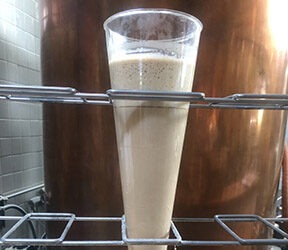Harvesting Yeast: Tips from the Pros
Brewer: Steve Dresler, Sierra Nevada Brewing in Chico, CA
Our preference is to deal with a single strain of yeast. It makes management of the yeast that much easier. When you have multiple strains, it is more difficult to keep the yeast strains and yeast generations separate. You end up with a considerable danger of cross contamination, which would destroy the integrity of the yeast.
For that reason, we have used a single strain since 1980. We propagate up a lager yeast once or twice a year for our seasonal program, but it is completely isolated in a different section of the plant and always kept in closed containers. We propagate our yeast from slants, building them up until there is enough to pitch a 200-barrel fermenter. Our ale yeast is used for 15–20 generations. After the twelfth generation, we begin propagating the new batch.
Once we start a new yeast propagation, all of a sudden we are dealing with two yeast batches of the same strain, but of different generations — one is at least twelve generations old, the other is only one. In this instance, despite the fact that they are the same strain, if we mix them up, the new propagation is ruined.
All that said, we have never been able to quantify exactly why we re-propagate our yeast and dispose of the 20th-generation yeast even when it is still performing so well. The first few fermentations with a new yeast tend to be slower. Also, the young yeast imparts a more ester-like flavor (though it ages out pretty quickly). The simple fact is, a long time ago we made a quality control decision to dispose of yeast after twenty batches. It is a policy that works well for us, and we’re sticking with it.
Homebrewers would really have to brew like crazy to get 20 generations out of a batch of yeast. Most homebrewers (and brewpubs for that matter) do not have the kind of brewing regimen to overcome the major issue of yeast viability. This is the simple fact that yeast will die if it is not actively being used.
If you do collect yeast, keep it chilled as close to 32 ºF (0 ºC) as possible. When it comes time to use it, rouse the yeast with a boost of oxygen. This can be done by vigorous stirring. Be sure to use a sterile spoon or whisk to get a bunch of froth going. The object here is to increase the metabolic activity before pitching the yeast.
Yeast aeration creates lots of activity necessary for cellular division. There is actually a pretty extreme view among some brewers that, if you aerate the yeast enough, you will not need to aerate the wort anymore. The idea being, once you give the yeast enough oxygen, it is already in the active growth phase and switches over to the stationary fermentation phase (where it can complete fermentation).
Yeast collection is really not a very big deal if you just remember to be clean about it! If you have an open container (or one that is easily opened) and you are making ales, I would suggest skimming off the yeast when the beer is fermenting at high krausen. Put the yeast in a sterile container and whisk it vigorously. This whisking concentrates the yeast solids by getting the carbon dioxide out (created during fermentation). Removing the carbon dioxide is good for yeast viability.
For brewing lagers, I would suggest scooping the yeast out from the bottom of the fermenter when you transfer from the primary to the secondary fermenter. A flat bottom fermenter means lots of trub and stuff in the yeast, but this problem isn’t too hard to deal with.
One way to get all this this trub away from your brew, is to transfer the beer after two or three days of
fermentation. The trub and dead yeast would have settled by then in the first tank. When fermentation finishes in the second vessel, mostly good yeast will be left behind.
Once you collect the yeast, I suggest following the advice of Chris White of White Labs. He has written about storing yeast under a layer of sterile, distilled water. This prevents the yeast from being in contact with air. Oxygen prevents yeast from going into the total dormant stage. A bit of beer from your fermenter could also serve as a good replacment for the distilled water in this practice.



